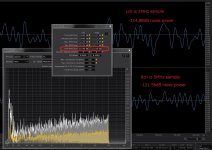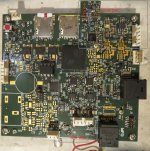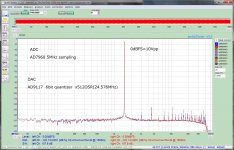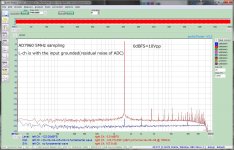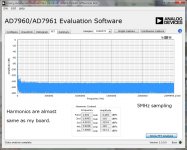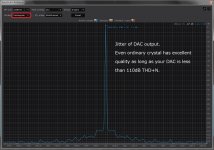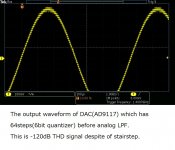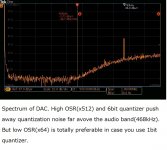The attached is noise power of SAR ADC with the input grounded. L-ch is 1MHz sample and R-ch is 5MHz sample. 5MHz is better than 1MHz by almost 7dB because of 10log5. SAR usually outputs raw captured data. DSM ADC must have an internal digital filter to convert DSM data to PCM. There is a chance high sampling rate in DSM ADC doesn't improve SNR of converted PCM. But I'm sure SNR of raw data captured by ADC is theoretically improved by oversampling, and my experience also says yes.
Attachments
My original purpose of designing ADC was also to archive my vinyl in digital format. The first version which used pcm4202 was three or four years ago. The second one with AD7982(1MHz sample) is my current version and used for archiving much vinyl. I'm sure the second one is enough performance for a music file.
But now I'm designing the third one to realize the best performance as possible for measurement purpose. Tha's why I use AD7960(5MHz sample) this time to achieve 120dB SNR and 120dB SFDR. The new version has almost fixed. I need to arrange environment to measure its performance. It takes some time.
Any updates on your adc?
SAR ADC and DSM DAC
Hi, dabore84. I have fixed SAR ADC. The 1st pic is my PCB (10cm X 10cm). The 3rd version has onboard RIAA equalizer(lower left) because this is initially for digitalizing my vinyl. SAR ADC AD7960(5MHz sampling) has an excellent performance not only music file but also measurement instrument. I need to have onboard DAC which has low enough THD to certify the AD7960. I usually use multi-bit DAC(pcm1704) for listening music. But for that purpose, DSM DAC is necessary because of its excellent THD. That's why I started to design DSM DAC together with SAR ADC.
Designing SAR ADC is straightaway. Counters, shift registers and logic gates in FPGA finally take you to the goal. But DSM DAC with low THD was a long and winding road. It took much time than I had expected. Now I have almost fixed DSM DAC like the attached pics. The AD7960 has stable performance. L-channel and R-channel have the nearly same characteristic, which you can use to upsample by two(5MHz x 2=10MHz). The residual noise of ADC at a 5MHz sampling is -122dBFS(0dBFS=10Vpp), which is almost the same value as theoretical one. If you do upsample by L-ch and R-ch, you have -125dBFS which is very difficult to achieve by DSM ADC.
I have EV-board of AD7960 made by Analog Devices. It has almost the same numbers as my board. But less than -120dBFS THD isn't guaranteed one of course. The amplitude isn't reliable though the frequency is correct. Anyway, I'm sure the AD7960($50) is the chip for the buck.
As to DSM DAC, I discarded commercial DSM chips when I decided to use pcm1704 after several listening tests because they didn't have strong bass for me. But Small FPGA in QFP(xc6slx9) and AD9117 may have some possibility for my current audio system. I'm planning to design small DSM DAC PCB without SAR ADC for my personal use. I'm sure DIYed DSM DAC, not commercial one is worth making.
Hi, dabore84. I have fixed SAR ADC. The 1st pic is my PCB (10cm X 10cm). The 3rd version has onboard RIAA equalizer(lower left) because this is initially for digitalizing my vinyl. SAR ADC AD7960(5MHz sampling) has an excellent performance not only music file but also measurement instrument. I need to have onboard DAC which has low enough THD to certify the AD7960. I usually use multi-bit DAC(pcm1704) for listening music. But for that purpose, DSM DAC is necessary because of its excellent THD. That's why I started to design DSM DAC together with SAR ADC.
Designing SAR ADC is straightaway. Counters, shift registers and logic gates in FPGA finally take you to the goal. But DSM DAC with low THD was a long and winding road. It took much time than I had expected. Now I have almost fixed DSM DAC like the attached pics. The AD7960 has stable performance. L-channel and R-channel have the nearly same characteristic, which you can use to upsample by two(5MHz x 2=10MHz). The residual noise of ADC at a 5MHz sampling is -122dBFS(0dBFS=10Vpp), which is almost the same value as theoretical one. If you do upsample by L-ch and R-ch, you have -125dBFS which is very difficult to achieve by DSM ADC.
I have EV-board of AD7960 made by Analog Devices. It has almost the same numbers as my board. But less than -120dBFS THD isn't guaranteed one of course. The amplitude isn't reliable though the frequency is correct. Anyway, I'm sure the AD7960($50) is the chip for the buck.
As to DSM DAC, I discarded commercial DSM chips when I decided to use pcm1704 after several listening tests because they didn't have strong bass for me. But Small FPGA in QFP(xc6slx9) and AD9117 may have some possibility for my current audio system. I'm planning to design small DSM DAC PCB without SAR ADC for my personal use. I'm sure DIYed DSM DAC, not commercial one is worth making.
Attachments
My music file is classical one recorded in 50's or 60's. You have two choices to listen to such old performance. One is remastering version in CD or hires file. The other is from old vinyl published those days. I tried both and was retired from the former because they are not what they were. My conclusion is remastering destroys their original sound.
Old vinyl has much durability than many people think and high fidelity which was lost in modern recordings. The best solution for me is to digitize old vinyl for excellent sound which can take me to 50's and 60's. My destination is not to design a DAC or ADC but to "timetravel" to the past by vinyl. Total SQ depends much on the music file. Both designing a DAC and making my original music file are the point for me.
Old vinyl has much durability than many people think and high fidelity which was lost in modern recordings. The best solution for me is to digitize old vinyl for excellent sound which can take me to 50's and 60's. My destination is not to design a DAC or ADC but to "timetravel" to the past by vinyl. Total SQ depends much on the music file. Both designing a DAC and making my original music file are the point for me.
I want to digitize ex-yu vinyl (music in former Yugoslavia between 1960-1990). The cd equivalents of some recordings is either non-existent or sounds like recorded in mp3 format from a mobile phone. Therefore I'm left with only one choice.
I am also at the very beginning of this journey, at the concept stage. And I also have the same destination to "time travel" with music.
You use the eval board, did you based the design of your DAC from it, or is it a heavily modified version?
I am also at the very beginning of this journey, at the concept stage. And I also have the same destination to "time travel" with music.
You use the eval board, did you based the design of your DAC from it, or is it a heavily modified version?
My ADC is almost same as the EV board by Analog Devices.
The difference is ADC driver. Mine is AD4898 while EV board is AD4899. Both have excellent performance except for absolute rating of a power rail. AD4898 is 36V. AD4899 is 12.6V. AD4898 is more convenient to use and a dual OP amp.
The most important thing but rarely noted is a reference voltage. EV board uses ADR4550, which is a usual selection in general but not good for an audio application where low frequency is important. SAR ADC has many input pins for a reference voltage because of its topology. For example, AD7960 has four reference voltage pins and three dedicated GND pins. It needs much current from a reference voltage. Normal REF like ADR4550 has excellent temperature coefficient but has relatively large output impedance which often results in less SNR.
My second version ADC had such problem. I did many trial and error to find where the noise came from. I found finally it came from reference voltage like ADR4550. After changing it to normal low noise voltage regulator, the noise faded away. What SAR ADC wants in an audio application is not thermal stability but a low impedance to sink much current. That's why my 3rd version has LT3042 for voltage reference. This works well and easy to change the voltage.
The difference is ADC driver. Mine is AD4898 while EV board is AD4899. Both have excellent performance except for absolute rating of a power rail. AD4898 is 36V. AD4899 is 12.6V. AD4898 is more convenient to use and a dual OP amp.
The most important thing but rarely noted is a reference voltage. EV board uses ADR4550, which is a usual selection in general but not good for an audio application where low frequency is important. SAR ADC has many input pins for a reference voltage because of its topology. For example, AD7960 has four reference voltage pins and three dedicated GND pins. It needs much current from a reference voltage. Normal REF like ADR4550 has excellent temperature coefficient but has relatively large output impedance which often results in less SNR.
My second version ADC had such problem. I did many trial and error to find where the noise came from. I found finally it came from reference voltage like ADR4550. After changing it to normal low noise voltage regulator, the noise faded away. What SAR ADC wants in an audio application is not thermal stability but a low impedance to sink much current. That's why my 3rd version has LT3042 for voltage reference. This works well and easy to change the voltage.
My ADC is almost same as the EV board by Analog Devices.
Hello and congrats for all your research. I´m uprading some of my old RME Fireface 800 components for better quality, specially opamps. I got very curious about all this... I see lots of DAC DIY designs out there to buy, but very few ADC DSD ones. I wish to build one with high precision specs components, a pair of channels for mastering purposes. Minimalistic as possible. Do you have any schematics or pcb models to share?.
I guess this question was made a lot but... natively recorded PCM 24/192 sounds noticiable "better" or "worst" respect a converted file from DSD origin? I guess the question could be if the sound "signature" of DSD new ICs is somehow better than the old pcm ones. In that case one could resolve to use PCM converted DSD files, until some osx daw appears.
Thanks a lot!. Cheers
I had a great post but was gone at the end... so sorry if I do not explain a lot 
I stepped into this and would like to know: Native 24/192 PCM recordings sound "better" or "worst" against converted from DSD files?
Im curious about the sound "signature" of PCM ICs vs newer ones that do DSD and PCM. Maybe it could be interesting to record DSD and mix converted files, until some simple OSX DSD DAW appears.
I stepped into this and would like to know: Native 24/192 PCM recordings sound "better" or "worst" against converted from DSD files?
Im curious about the sound "signature" of PCM ICs vs newer ones that do DSD and PCM. Maybe it could be interesting to record DSD and mix converted files, until some simple OSX DSD DAW appears.
I can't understand what you really mean because your definition of PCM and DSD are not clear for me. Recent ADC has two major topologies. One is SAR which has internal multi-bit DAC and doesn't have native DSD(1 bit DSM) output. The other is DSM which probably uses DSD but multi-bit DSM is also possible. The output of DSM ADC is usually DSD and PCM which is converted from DSD output.
If you want DSD data, SAR ADC needs DSD modulator which converts PCM into DSD. A hardware solution is also possible by relatively small-scale FPGA. I don't know which is better because native DSD doesn't always have optimum algorithm than converted one. I prefer DSD converted from PCM. In that situation, I can do try and error to achieve an excellent result. There are many parameters in making DSM, OSR ratio, numbers of an integrator, and NFB topology.
If you want DSD data, SAR ADC needs DSD modulator which converts PCM into DSD. A hardware solution is also possible by relatively small-scale FPGA. I don't know which is better because native DSD doesn't always have optimum algorithm than converted one. I prefer DSD converted from PCM. In that situation, I can do try and error to achieve an excellent result. There are many parameters in making DSM, OSR ratio, numbers of an integrator, and NFB topology.
xx3stksm - I am very impressed by the work you have shared, would love to hear some samples. I have not seen anyone using these converters for audio applications. Are you capturing the high-speed 5msps signal at 18-bit per channel to a computer?
Are you planning to make boards or plans available? I'm sure you could sell them easily, as these converters would also find use in many other demanding applications; test equipment, bat detectors, software defined radio, binaural/ambisonic recording, on-location audio recording, etc.
Did you consider capturing the Multi-bit DSM data out of one of the modern audio ADC converters?, such as the TI PCM4222 or Arda AT1201? These converters are similar to Delta-Sigma architectures, but internally are 6-bit differential encodings, either 128x OSR or 256x OSR, respectively, and offer raw "Multi-bit Modulator" data output modes. This would classify as a DPCM encoding, and is not just a high-speed PCM output. This would require a specific solution for converting DSM(MBM) to DSD or PCM.
Are you planning to make boards or plans available? I'm sure you could sell them easily, as these converters would also find use in many other demanding applications; test equipment, bat detectors, software defined radio, binaural/ambisonic recording, on-location audio recording, etc.
Did you consider capturing the Multi-bit DSM data out of one of the modern audio ADC converters?, such as the TI PCM4222 or Arda AT1201? These converters are similar to Delta-Sigma architectures, but internally are 6-bit differential encodings, either 128x OSR or 256x OSR, respectively, and offer raw "Multi-bit Modulator" data output modes. This would classify as a DPCM encoding, and is not just a high-speed PCM output. This would require a specific solution for converting DSM(MBM) to DSD or PCM.
High-speed sampling is for high SNR in the audio application. Inherent resolution of AD7960 is 18bit. But actual bit resolution is determined by SNR, where bandwidth is the most critical factor. The lower bandwidth, the higher bit resolution. I would say 20bit is the best in 20kHz bandwidth like audio application. The available bit resolution is 20bit at max even if your ADC claims 24 or 32bit because SNR dominates noise floor.
Raw data of 5MHz(24.576/5) is not directly used. My final sampling frequency is 96kHz/24bit. Captured data by 24.576/5 is downconverted to 153kHz(24.576/(5*32)) by the first decimation filter. The second one is 5/8. Then you have (24.576/(5*32))*(5/8)=96kHz. The advantage of SAR ADC is arbitrary division ratio whatever you want. A commercial ADC chip has only the fixed one. I have another sampling frequency, 24.576/6=4.1MHz. This is more practical than 5MHz because it requires high-performance op-amp which has the ultimate driving ability.
I would say 4.1MHz((24.576/(6*32))*(3/4)) sampling is a more convenient way than 5MHz.
My ADC is still on the way. Captured 96kHz data is written into SD card in fat32. But exFAT is better for SD card interface. I need to rewrite firmware to be able to handle exFAT. I already have read interface to SD in exFAT. It takes some time to write the code of write operation in exFAT. This doesn't have high priority in my todo list because fat32 is enough for my personal use. That's why I have no plan to sell the ADC board. I have already quit from a business. An audio person old enough to live only with a hobby.
Raw data of 5MHz(24.576/5) is not directly used. My final sampling frequency is 96kHz/24bit. Captured data by 24.576/5 is downconverted to 153kHz(24.576/(5*32)) by the first decimation filter. The second one is 5/8. Then you have (24.576/(5*32))*(5/8)=96kHz. The advantage of SAR ADC is arbitrary division ratio whatever you want. A commercial ADC chip has only the fixed one. I have another sampling frequency, 24.576/6=4.1MHz. This is more practical than 5MHz because it requires high-performance op-amp which has the ultimate driving ability.
I would say 4.1MHz((24.576/(6*32))*(3/4)) sampling is a more convenient way than 5MHz.
My ADC is still on the way. Captured 96kHz data is written into SD card in fat32. But exFAT is better for SD card interface. I need to rewrite firmware to be able to handle exFAT. I already have read interface to SD in exFAT. It takes some time to write the code of write operation in exFAT. This doesn't have high priority in my todo list because fat32 is enough for my personal use. That's why I have no plan to sell the ADC board. I have already quit from a business. An audio person old enough to live only with a hobby.
- Status
- This old topic is closed. If you want to reopen this topic, contact a moderator using the "Report Post" button.
- Home
- Source & Line
- Digital Line Level
- DSD adc
